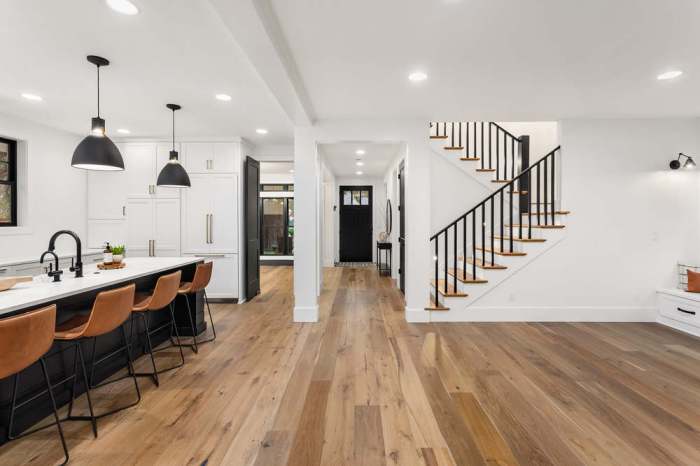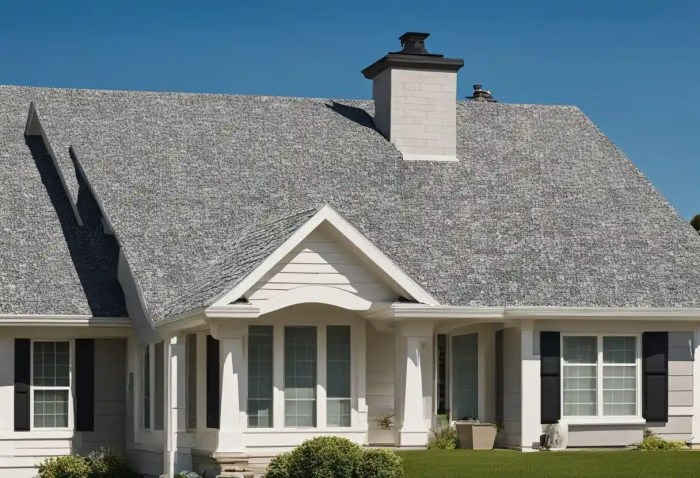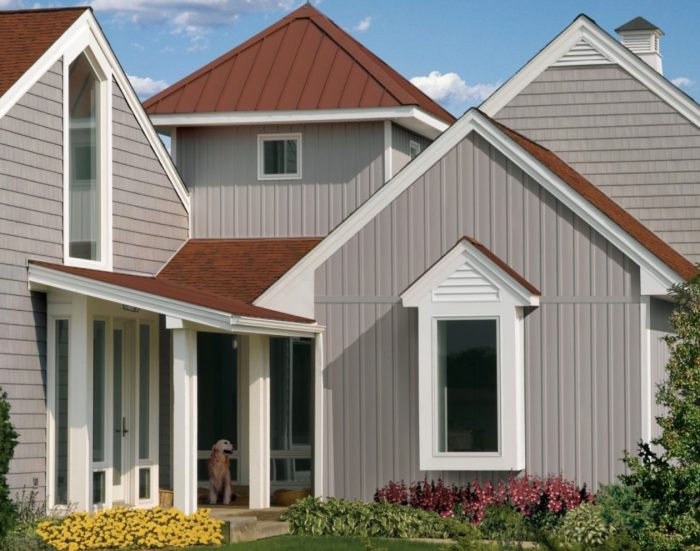The Ultimate Guide to the Best Flooring for Home Remodel
Best flooring for home remodel sets the stage for this enthralling narrative, offering readers a glimpse into a story that is rich in detail and brimming with originality from the outset. From hardwood to vinyl, we delve into the world of flooring options to help you make the best choice for your home remodel.
As we explore the benefits, drawbacks, trends, and maintenance of different flooring types, you'll gain valuable insights to elevate your home design.
Types of Flooring
When it comes to choosing the right flooring for your home remodel, there are several options to consider. Each type of flooring has its own set of benefits and drawbacks, as well as unique features that may suit different preferences and needs.
Hardwood Flooring
Hardwood flooring is known for its timeless appeal, durability, and ability to add warmth to any room. However, it can be more expensive upfront and may require regular maintenance such as refinishing to keep it looking its best.
Laminate Flooring
Laminate flooring is a cost-effective alternative to hardwood, with a wide range of designs and styles available. While it is easy to clean and maintain, laminate may not be as durable as hardwood and can be prone to scratching.
Vinyl Flooring
Vinyl flooring is a versatile and affordable option that is resistant to moisture and easy to install. However, it may not have the same level of durability as hardwood or laminate, and can be susceptible to damage from heavy furniture or sharp objects.
Tile Flooring
Tile flooring is a popular choice for areas with high moisture, such as kitchens and bathrooms, due to its water resistance and durability. While it is easy to clean and comes in a variety of styles, tile can be cold underfoot and may crack or chip over time.
Carpet Flooring
Carpet flooring is known for its comfort and warmth, making it a cozy option for bedrooms and living areas. However, carpet can be more challenging to clean and maintain compared to hard surface flooring, and may not be as durable in high-traffic areas.
Considerations for Choosing Flooring
When it comes to choosing flooring for your home remodel, there are several important considerations to keep in mind. Factors such as room usage, foot traffic, budget, style, and ease of installation play a crucial role in determining the best flooring option for your space.
Selecting Flooring Based on Room Usage and Foot Traffic
- High-traffic areas like the living room or kitchen require durable flooring options such as hardwood, laminate, or tile.
- For bedrooms or low-traffic areas, carpet or luxury vinyl may be more suitable for a softer and cozier feel.
- Bathrooms and laundry rooms need water-resistant flooring like ceramic tile or vinyl to withstand moisture and humidity.
Factors to Consider: Budget, Style, and Ease of Installation
- Consider your budget and choose a flooring option that aligns with your financial constraints. While hardwood may be more expensive upfront, it can add long-term value to your home.
- Select a flooring style that complements your interior design aesthetic. Whether you prefer a modern, rustic, or traditional look, there are various flooring options available to match your style.
- Ease of installation is another crucial factor to consider. If you're looking for a DIY-friendly option, consider laminate or luxury vinyl planks that are easy to install without professional help.
Matching Flooring Types with Interior Design Styles
- For a sleek and modern look, consider concrete or polished tile flooring that offers a clean and minimalist aesthetic.
- Rustic interior designs pair well with hardwood or reclaimed wood flooring to add warmth and character to the space.
- To achieve a cozy and inviting atmosphere, carpet flooring in neutral tones can create a comfortable and relaxed ambiance.
Popular Trends in Flooring
When it comes to flooring trends for home remodels, staying up to date with the latest materials, colors, and patterns is essential. Homeowners are increasingly looking for flooring options that not only look stylish but also offer sustainability and eco-friendliness.
Here, we will explore some popular trends in flooring and how you can incorporate them into your home while maintaining a timeless look.
Wood-look Tiles and Vinyl Planks
One of the current trends in flooring is the rise of wood-look tiles and vinyl planks. These options provide the warmth and elegance of hardwood floors but offer greater durability and ease of maintenance. They come in a variety of colors and finishes, making them versatile for different design aesthetics.
Luxury Vinyl Tile (LVT)
Luxury Vinyl Tile (LVT) is another popular choice for homeowners looking for a high-end flooring option that is also budget-friendly. LVT comes in a wide range of patterns and colors, including options that mimic natural stone or wood. Its water-resistant properties make it ideal for kitchens and bathrooms.
Bamboo and Cork Flooring
For those interested in eco-friendly flooring options, bamboo and cork are gaining popularity due to their sustainable properties. Bamboo is a fast-growing renewable resource, while cork is harvested from the bark of cork oak trees without harming the tree. Both materials offer unique textures and colors that can add a natural touch to your home.
Geometric Patterns and Bold Colors
To add a touch of personality to your space, consider incorporating geometric patterns and bold colors into your flooring design. Whether through tiles, carpets, or hardwood stains, geometric patterns and vibrant hues can make a statement and elevate the overall look of your home.
Flooring Installation and Maintenance

Installing and maintaining flooring is a crucial part of any home renovation project. Proper installation ensures longevity and durability, while regular maintenance helps retain the aesthetic appeal of the floors. Below are some key points to consider for flooring installation and maintenance:
Steps for Installing Different Types of Flooring
- 1. Preparation: Clear the area of furniture and ensure the subfloor is clean and level.
- 2. Acclimation: Allow the flooring material to acclimate to the room's temperature and humidity.
- 3. Installation: Follow manufacturer guidelines for each type of flooring, whether it's floating, glue-down, or nail-down.
- 4. Finishing Touches: Trim edges, add transition pieces, and apply sealant or finish as needed.
Tips for Proper Maintenance and Cleaning
- 1. Regular Cleaning: Vacuum or sweep floors regularly to remove dirt and debris that can scratch the surface.
- 2. Avoid Water Damage: Wipe up spills immediately to prevent water damage and staining.
- 3. Use Protective Pads: Place felt pads under furniture legs to prevent scratches and dents.
- 4. Follow Manufacturer Instructions: Use recommended cleaning products and methods to preserve the flooring material.
Common Issues During Flooring Installation and Troubleshooting
- 1. Uneven Subfloor: Level the subfloor before installation to prevent gaps or buckling.
- 2. Moisture Problems: Address moisture issues before installing flooring to prevent warping or mold growth.
- 3. Improper Installation: Ensure proper installation techniques are followed to avoid issues like loose planks or tiles.
- 4. Scratches and Wear: Use area rugs in high-traffic areas and apply protective coatings to reduce wear over time.
Concluding Remarks
In conclusion, the best flooring for home remodel is not just about aesthetics but also functionality. By understanding the nuances of each flooring type and considering your specific needs, you can transform your space into a stylish and durable haven.
Dive into the world of flooring options and embark on a journey to revitalize your home with the perfect flooring choice.
Question & Answer Hub
What flooring type is best for high-traffic areas?
Laminate flooring is a durable and cost-effective option for high-traffic areas, offering both style and resilience.
Can hardwood flooring be installed in bathrooms?
Hardwood flooring is not recommended for bathrooms due to its susceptibility to moisture damage. Consider waterproof options like vinyl or tile instead.
Is it possible to install new flooring over existing flooring?
In some cases, you can install new flooring over existing flooring if the conditions are right and the existing floor is in good condition. Consult with a professional for the best approach.




